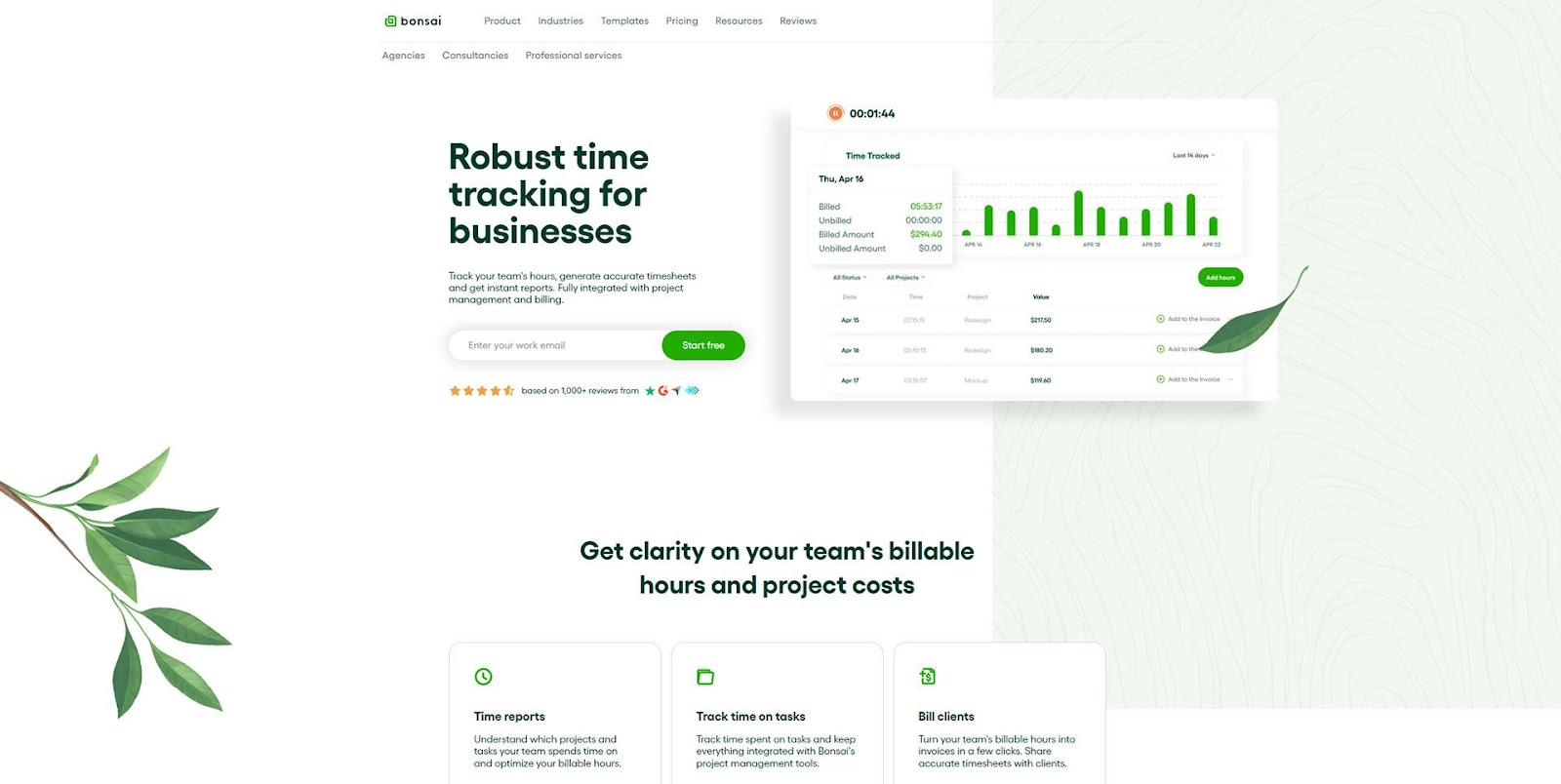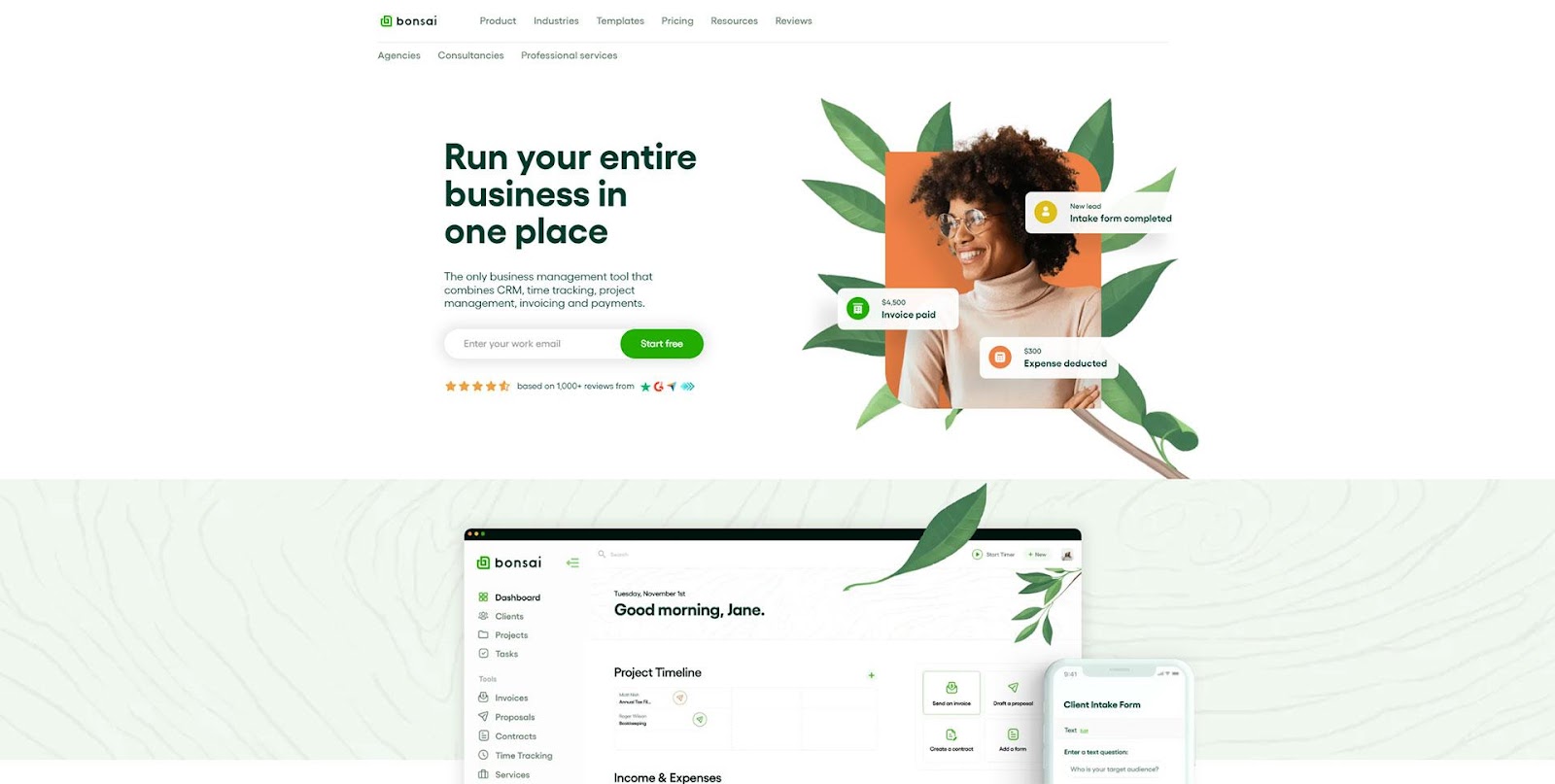Creative agencies have seen a huge uptick over traditional advertising and campaign agencies, with around 9% market growth year-over-year. Their capability to provide a better variety of services, including in-house media and campaign design, allows them to offer a holistic service at a more attractive price point. This creates a more entrenched company-client relationship, allowing agencies to zero in on delivering steady results on a few select clients.
However, creative agencies typically suffer from scope creep and insufficient collaboration between key company members. Combined with the need to juggle a few projects at different points in their pipeline, and you get a recipe for improperly tracking how long a project takes to complete. As a result, the agency might be severely underselling its services and losing money despite having active projects.
Fortunately, that’s where creative agency time-tracking software can help. Read on to discover how integrating this tool into your project management system can streamline your workflow and help boost your team morale.

Benefits of time tracking software for creative agencies
Operating a creative agency involves numerous business tasks, including tracking work hours, managing projects, and handling agency fees. Implementing a suitable software system can streamline these processes, freeing up more time for creative work. One such solution is time-tracking software tailored for the creative industry.
Discover how effective project management can streamline your creative agency's workflow. We provide efficient time tracking software that draws from the principles outlined in project management with time tracking. This tool will help you stay on top of all your agency's projects, ensuring nothing slips through the cracks.
At first, you might think that time-tracking software only allows you to check how long your employees are spending on projects. However, that’s only a sliver of what time tracking will provide for a creative agency.
Let’s dig a little deeper into all the benefits you could reap from it.
Improved budget and cost estimates
One of the primary issues for small businesses is improper cashflow planning. Spending too much time on a big project without requesting adequate pay can severely dampen your agency’s ability to pay employees and find other clients.
With a time management tool connected to your project management software, you can see just how much each aspect of a project actually takes to complete. You can use this data to create more accurate invoices for your clients.
You can also use this crucial information to plan your company’s future. The data from past projects can guide accurate budget proposals for future projects. With that, you’ll have a much easier time estimating each client’s expected ROI (return on investment) and their customer lifetime value (CLV). These benchmarks are vital in ensuring that your company is maximizing the use of its resources.
Improved project management
At its core, project management is based on managing the resources available to your company. This can be software, hardware, office space, and even people. By leveraging time tracking in your daily work, you’ll quickly notice patterns that can positively or negatively affect project completion, costs, and even employee morale.
You can use the data to make more informed decisions on allocating project deadlines and ensuring that the teams can focus on the critical project milestones without worrying about lower-priority projects. For example, if your creative company is creating video content in-house, the filming studio can make a significant bottleneck in your operations. It likely needs a few people to manage, and you can only feasibly shoot videos for one project at a time. With time-tracking information, you can create a schedule to maximize studio time and prevent project clashes and excessive downtime.
If your company is larger, you can leverage data on how long certain designers take when completing tasks to assign them to projects that better align with their skillset and interests. By doing so, you can improve their morale (and productivity) by ensuring that they work on something they already love doing rather than just going to work to get paid.
Better client relations
While creative agency time-tracking software is essential in creating more accurate invoices so you get paid what you deserve, this can also benefit your clients. With a better overview of costs and how much time it takes to complete certain project milestones, they get a detailed picture of what your company provides.
As a result, your client relationships are supported by accurate, timely information. It creates a level of transparency that your clients will appreciate. If you leverage data from previous projects to estimate project scope and costs, the client is much more likely to choose you as their service provider. Since everything is laid out at the start, you can enter project negotiations with less uncertainty and ensure that both sides leave with the best possible deals.
Improved customer relations and brand trust have only become more important with recent changes to remote work adoption and adaptive business models. According to research by Edelman, over 60% of consumers are belief-driven, meaning they’re more likely to work with brands that they trust. With competition growing all around you, your brand needs to exude confidence and transparency in all aspects of work, including pricing and estimates.
Coordinating remote teams
The pandemic has shown that many people don’t need to sit in an office for eight hours a day and commute for a few more to build websites, design logos, or write content. And agencies have usually improved and profited because of it. Regardless of your stance on whether remote work improves productivity (since there’s still some ongoing debate on that), agencies can now hire from pretty much every corner of the world. Remote working has vastly improved the available pool of candidates and ensured teams align with company culture and expectations.
However, working remotely also presents a unique set of challenges. With people spread across time zones and projects, you must make a concerted effort to manage the logistics involved in making team members coordinate on vital tasks and join vital team meetings.
With creative agency time-tracking software, you eliminate most of those worries. You can get up-to-date reports on how each stage of your projects is progressing and learn what times and schedules work best for your team members and how to align them to maximize productivity.

Differentiating between billable and non-billable hours
One of the key reasons companies might fail to properly budget for their projects is underestimating how internal operations clash with project-related activities.
Your creative agency still needs someone to do payroll, create accurate timetables, and manage team meetings. If you’re running a tight ship, some of these crucial management tasks can fall down on the same people who are vital in ensuring the project milestones are being met and that the tasks are delegated to the people who are best at them.
Additionally, a creative agency might need to take some time between working on projects to meet its own needs. For example, if your business creates content for clients, you’ll likely need to set aside some time and personnel to create content for your company website. If you’re experts in organic marketing, you can’t afford to lose potential clients by losing track of your company’s own marketing efforts.
Your project management and time-tracking software can help you better understand how your billable hours stack against these vital yet essential unpaid “projects” you must complete. With that information, you can create a more adaptive work strategy and optimize your operating costs. Ultimately, this can help you design more efficient processes—both internal and client-related—and help you navigate long-term budget estimates to project your company’s growth.
Automated billing and invoicing
If you use automated time-tracking software, that data can quickly become available for your billing software to use. Based on that, you can create accurate bills or invoices to send to clients. If your software integrates with client relationship management software (CRM), then the process is further streamlined.
Correlating time-tracking with billing allows your agency to spend much less time figuring out how to charge clients. It eliminates almost all mistakes made due to human error during data entry.
Keep in mind that your time-tracking software may not be perfect at detecting active working hours. For example, most creative endeavors come in bursts, which can heavily skew data if the software only tracks user activity.
In these cases, it helps to have software that can more accurately tell how long a person has been working and even allow for seamless manual input and rewriting of past data. However, the tool also needs to be secure enough to prevent misuse. Otherwise, it may become complicit in wage theft, which costs employees across the U.S. over $50 billion per year.
Improved team member analytics
One of the biggest challenges you might encounter when running a creative agency is team morale and individual time management.
Unfortunately, the nature of creative work rarely pairs well with the ability to manage time accurately and play well inside a larger team. When hiring a designer to come up with a perfect logo, you have to balance between a person who has the most skills and one who can do the job on time.
With time-tracking software, you can better understand team members’ productivity peaks and how their personalities, skills, and preferences align with the project specifics and requirements. Backed with that data, you can create more tailored plans that allow your team members to stay grounded, ensuring you reach your deadlines and stay within the project’s budget.
Data-driven decisions
The best creative agency time-tracking software allows management to create detailed reports on every team member’s productivity over longer periods. It’s an invaluable tool for noticing patterns and inconsistencies in project completions, milestone management, and resource allocation.
Backed with time-based information, your team can make more accurate predictions on project milestones. When combined with highly detailed reports from your project management and CRM software, you can design more comprehensive project pipelines. You can more accurately allocate key team members for crucial project procedures and time them well enough to ensure minimal overlap or downtime.
These data-driven practices will ultimately create a more seamless user experience and boost your throughput rate and project completion. It also makes more room in your schedule to account for feature creep, which can sometimes feel like an inevitable part of the creative process. In some cases, you can predict possible additions and up-selling opportunities for the client, ensuring that you’re prepared for the next phase in a long-term client relationship, further boosting the expected CLV.
You can also use the information you receive from your time-tracking software to pair it with your bookkeeping and CRM tools. You can use this to allocate sufficient time and resources for your most valuable long-term clients. According to the Pareto Principle, a business typically receives 80% of its income from only 20% of its clients. By leveraging time-tracking software, you can ensure that most of your efforts go to the clients who account for most of your company’s success. It can create a positive feedback loop that allows your company to expand and diversify.
What to look for in time tracking software
In general, time-tracking software usually comes with enough bells and whistles to ensure that you can comfortably use any given tools and get a solid productivity increase. At its core, it needs to track how much time your workers spent on certain tasks or projects.
However, generalistic tools frequently fail to account for the specific needs of your industry and even the scope of the projects your company is managing. Keep an eye on the following features when narrowing your list of options.

Simplicity and accessibility
At its core, time-tracking software needs to become second nature. If your employees fail to use it effectively, they might often need to manually input data long after the project has been completed. Given that each employee is likely working on several smaller projects at a time and needs to rapidly switch between them, it can lead to heavily skewed information that would need to be corrected.
At best, this leads to management needing to spend more time crawling through historical data. At worst, your agency might not get paid what it deserves.
However, the tool must also be simple enough to ensure that team members can quickly organize their timetable and manually input their time-tracking if they haven’t done so.
One of the simplest ways to use time-tracking software is to turn it on at the start of the shift or session and then have the tool automatically stop and record data once you turn it off. After a few days, your employees and contributors can develop it into a habit.
Automation options
If you want more control over time-tracking, then a tool that can automatically track activity will be an excellent choice. It’s not a perfect solution, owing to the fact that many tools rely simply on mouse activity and can be spoofed with emulators. Still, it’s one of the easiest ways to get tangible data without relying on team member’s manual input.
This can be a great tool for tracking resource management for non-personnel. Active time-tracking for things like software or unique hardware tools can help you make schedules that limit downtime and prevent clashes between various team members or divisions needing to use the same resource.
Invoicing and bookkeeping integration
One of the simplest ways to use time-tracking software if you’re a small agency is to directly track your working hours and convert them into billable hours for the client. With the correct invoicing integration and automation tools, the software can accumulate your sessions and quickly sum them up into effective billable hours for each project. If you’re well-versed in using the tool for specific projects, you’ll likely need to do only minimal admin to ensure that you’re not overcharging (or undercharging) your clients.
On the bookkeeping side, a tool that can integrate with your accounting or bookkeeping software can be invaluable when determining or outlining budgets and performing cost analysis.
Collaboration options
Roughly 40% of agencies in the U.S. that provide advertising-related services have fewer than five employees. As such, your team is likely not equipped to deal with all the requirements of a full-service creative effort for a bigger client. Instead, you’ll need to rely on freelancers to bridge that gap and improve your productivity while minimizing inboarding costs.
With that in mind, your time-tracking tool can also become indispensable in ensuring that freelancers and independent contractors working with you get their fair share of income. If the tool can seamlessly integrate with other project-management tools, or you can give freelancers granular access to it, you can allow them to track their time in your native app. This will eliminate discord on overtime and ensure that you can accurately track freelancers, ensuring they mesh well with your company’s projects and overall culture.
Offline and mobile accessibility
Due to the general burstiness of creative endeavors, it can also help to ensure that your employees can step away from their computers and still be accounted for when solving issues that don’t require an internet connection. That’s why a tool that can track activity or be activated solely through a mobile platform is indispensable.
This can work well in an office setting if your team members need to access specialized equipment that isn’t available on their regular workstations or use additional design tools. The software will likely instantly sync that activity when they access their main platform again, ensuring that you get a more reliable and accurate measure of the time they spent on each phase of the project.
Cost and scalability
Of course, before you sign up for the first time-tracking software you see online, you need to ensure that the benefits you receive from it outweigh its costs.
In general, look for software that is multi-purpose (such as doubling as project management or CRM tool), has scalable payment plans, or both. This will ensure that you don’t get overburdened with highly specialized software that is draining your budget and has too many features oriented towards managing a much larger agency. You can start with the basic time-tracking tools you need to get better reporting and use that information to create a curated growth plan that will allow you to slot into the next feature scale.
Choose Bonsai as your creative agency’s time-tracking and management software
It's essential for a creative agency to correctly manage their time with the help of effective software. One incredible tool which we've discussed previously is an SEO project management software, adept at organizing project timelines and tasks. It's an asset for keeping track of SEO projects and should be considered by agencies that tackle such complex field.
If you’re a creative person, you likely don’t have time to spend juggling between various software tools to manage your business and actually produce the content your clients need. You want a streamlined, no-fuss solution that lets you focus on doing the work that brought you into the industry in the first place.
That’s where Bonsai comes in.
Bonsai is a full-service time-tracking, project management, CRM, and bookkeeping tool designed to help you scale your agency from a small business to an international corporation.

The time-tracking options couldn’t be simpler—just open the platform, choose the project you’re working on, and start the timer. Bonsai will track your activity and automatically sync how much time you spent working with your hourly rate for the project, allowing you to add that to your invoice. You can do a bit of manual fine-tuning if necessary, and you’re ready to submit a detailed report to the client.
Bonsai also allows you to track your projects and your client documentation in the same app. It streamlines your processes and helps you stay focused on completing projects while worrying about budgets and deadlines later. With Bonsai’s curated reporting tools, you can get accurate information about your project milestones and productivity.
The tracking tools also allow you to hire collaborators easily. You can add a collaborator directly to the platform, create customized role access to your projects, and help them track their time more effectively. When their tasks are finished, they can quickly export that information into an invoice, helping you track your running costs.
Furthermore, Bonsai has an extensive collection of invoice, agency contract, and project proposal samples. You can leverage this knowledge base to customize your client experience and ensure that both parties receive full transparency on project scope and expectations.
Try out Bonsai today with a seven-day trial for full access to features and knowledge base, and learn why it’s one of the best time-trackers you can find.






